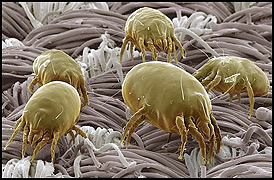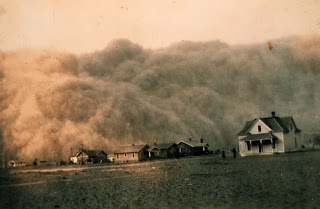 |
| Hans and Petra, my grandparents |
As an Oregonian, I tend to think my state stacks up favorably when compared with the other states, but I did suffer a flicker of envy the other day when I read about Arizona. A giant haboob just flew through there at speeds up to sixty miles per hour, and all we have is elk.
A haboob is a massive dust storm, and Arizona has a lot of them, although of course this one was a real dilly. Floods, tornadoes, hurricanes and haboobs alike have been overachieving for years now in spite of the sober judgment of dozens of prominent capitalists that there is nothing untoward happening with our climate. So it’s a puzzler.
Myself, I put it down to the trend towards obsessive housecleaning. I am not trendy. My preference is to fail to notice dust in the house, which is easier if you don’t disturb it and avoid sunbeams, which are rare here anyway. Over time, all surfaces develop a pleasing matte finish, and periodically–say, once a year or so–the whole accumulation can be neatly rolled up like felt. This is not the method preferred by my housemate, who suffers from higher standards. With his method there’s never any end to it; you’ll never quite get rid of the schmutz in the corners; and you can’t tell where the cat has been.
A huge component of house dust is shed skin cells, which pop off the body and onto the coffee table in the hundreds of thousands per day, like an epidermal diaspora. The cosmetics industry has so far ignored the potential of a mixture of dead skin cells and Lemon Pledge as a suitable face spackle, but not for lack of a market. Somebody would buy it. In fact there are no doubt some individuals who are embracing the unparalleled exfoliating properties of a good haboob. If you should see someone standing out naked when the haboobs roll through, he’s probably the sort who’s already carved away his own nose and injected himself with botulism. You can draw your own conclusions, although none of them support evolution.
Thanks to the proliferation of well-advertised dusting products, people are waging war on dust in the modern era, many of them claiming allergies. Dust allergies, they say, are really allergies to dust mites, which are organisms that like to eat our skin cells and, like tiny polite vultures, are kind enough to wait for them to die and fall off of us. In fact, though, no one is strictly allergic to dust mites, which are actually too large to become airborne where we can inhale them. Instead, they are allergic to dust mite poop. If you were looking for another sort of factoid, you should have visited a different blog.
My own mother was a regular duster. She devoted one day a week to it and was probably glad to do it. Once a week with the bottle of O’Cedar was a cakewalk compared to the Dust Bowl, when the entire state of North Dakota, among others, lost its skin cells. She relates that they had to sweep out the entire house three times a day, with a shovel, due to the local shortage of backhoes. What roiled through the air was valuable stuff, stuff you could grow wheat in if you had a little water, but if you had a little water it wouldn’t have roiled through the air. From what I gather, North Dakota may have been flat, but it had really big haboobs, although Mom never put it that way.
So it may have been her early experience that made my mom such a good housekeeper; I certainly have no evidence at hand that there was a genetic component. It would be interesting to see just how long I could go without dusting, if Dave weren’t around to inflict tidiness. There is something comforting about the thought of watching the house fill up with my own skin. That might not spin your propeller, but it’s about as close as we apatheists get to immortality. Maybe I could live long enough to see it wrinkle on the bookshelf. Maybe I could grow wheat.
Happy birthday, Mary Ann!



I read the title and thought, "Oh boy, a post about farts!" I was at first disappointed, but we eventually got around to poop so all is well in my world once again.
I, by the way, have dust bunnies so large they get up and walk around occasionally.
If you should see someone standing out naked when the haboobs roll through, he's probably the sort who's already carved away his own nose and injected himself with botulism. You can draw your own conclusions, although none of them support evolution.
Actually, this would be a rather good example of natural selection in action.
A mighty wind indeed — Arizona's sufferings under the flatulence of the Deity suggest that it has incurred His displeasure in some way, though as usual it's hard to guess exactly how.
The only good thing about such conditions is that it's hard to imagine dust mites flourishing in them.
Gosh Murr, Thanks! I have plenty of dust at the studio, if you want to observe it in its natural habitat. The creeping clean has only made a few dents in the upper stratum.
Roxie sez
I share your indifference to housework and have found it helpful to host a party about once a month. This stimulates me to tidy enough to keep the health department at bay. However, dusting never comes into it. There are surfaces in my house which have been gray felt for so long that we have forgotten the original color. A small, interior haboob might be a solution. Or a leaf-blower . . .
My dust bunnies are now dust buffalo and are quietly grazing the bookshelves. I'm so glad to hear of others who don't dust. I do, but it's also once a year, maybe twice, if company's coming.
That you're reading Mark Twain is very fitting.
I have discovered that dust bunnies have dust bunnies of their own. Who knew they could procreate? And a friend of mine says that not dusting
only shows if you move stuff
My mother was anal about housekeeping as long as she didn't have to do it.
Okay, so….
If dust mites eat skin cells, and poop them out, are we allergic to ourselves? We are, after all, entirely clothed in a custom made suit of the bloody things. So maybe we're allergic to dust mite SPIT.
If the storm passes to the east or west of a town, only affecting the border areas, is it a side-haboob?
I'm sorry.
Dust mite poop — thank you for that!
Now if you could just come up with a good reason for not mopping the kitchen floor.
I once read the theory (and have adopted it) that if you cease to dust a natural equilibrium is reached and the level stops increasing. I am pretty certain that there are flaws in the theory, but what theory is perfect anyway?
Wasn't it that self described 'Stately English Homo' Quentin Crisp who said, " I have a message of hope for the housewives of England, after four years the dust doesn't get any worse".?
I've decided to, conduct field trials to test his theory, shall publish my report in 2015.
The Dust Bowl: Apatheists vs. the haboob hunters.
It's blowin' peace and freedom
It's blowin' equality.
Hey, you bought that book quite a while back! You still haven't finished it? And I thought it took me a while to get through the book you told me to buy…
And, you can't blame it on too much housework!
I'm sure you're right, Murr. There must be no genetic component to zealous cleanliness. I have an hypothesis that its opposite in offspring has something to do with adolescent rebellion; but, of course, adolescent rebellion isn't supposed to last this long.
My mother vacuumed every day and cleaned the kitchen floor after every meal, all in addition to ironing the sheets and everyone's underwear, which must have freaked any surviving dust mites into mortal terror. I don't remember about dusting, but I never saw dust in the house–just on all of southeastern Idaho on the other side of the door. Dust in MY house? The less said the better.
I was just thinking that I should perhaps maybe dust, but you've convinced me otherwise. My other half doesn't seem to care – & in fact can get kind of snarly if I try to dust his laptop while he's using it.
Oh, I LOVE the idea of just leaving the dust, and rolling it up like felt once a year. Brilliant strategy, Murr. With four dogs (who merrily shed fur like we shed skin cells), if I apply the same principle to the floors, I'll have a lovely grey-brown shag carpet in no time.
Kat, you caught me. In my defense, it's a REALLY big book, and lends itself well to being dipped into, and I've been working on my own books to the exclusion of pleasure reading. But it is a really, really good book by my very hero.
Every other week our housekeeper brings her feather duster and moves it all around. That's good enough for me.
Dist Mite poop. Now I know why I am sneezing up a fit!
They say: "You may write in the dust…just don't DATE it." Author unknown.
Murr, you are not only collecting not only felted-dust, but a lot of ditto-heads. (Please excuse the expression right away). I always wait for your blog, but I'm beginning to feel a lot of your respondents are also one-of-a-kinds.
You are a splendid antidote to twitter (a complete and hilarious thought in every line) but you so excel Facebook. I can see you, hear you, even smell the meals your hubby cooks. Or was that dust mite poop?
Thanks, Shaatzie. I'm with you: one of these lazy days I'm just going to pop out a sentence (140 characters?) and let my commenters write this thing.
I don't dust either…I was just musing on that fact today as I gazed at the "felt" covering on my coffee table…
Thanks for another fact-filled, funny post, Murr!
Wendy
When I was a kid my mother had these elderly neighbors who she would visit and take me in tow. They had lamp shades with plastic covers and elastic to keep them on. Plastic on the sofa and chairs.. and those long plastic runners going down the hall and diagonally across the major traffic points through their house.
Oh my, Robert! I'd forgotten all about that. The Grazes down the street had plastic-coated furniture and runners like that. It always made me feel as though they thought I might poop on the furniture. Well, word gets around, I guess.
Thanks for this post. I never had heard of a haboob until now. I've always lived where we are more likely to experience hurricanes, tornados, and floods.
But I too think dust should be allowed to rest in peace.